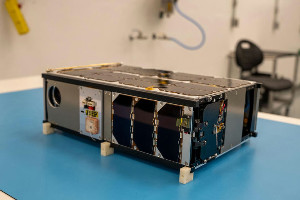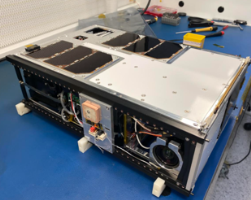| Satellite | CATSAT |
|---|---|
| Form factor | CubeSat |
| Units or mass | 6U |
| Status | Operational (Live dashboard as of 2024-12-22) |
| Launched | 2024-07-04 |
| NORAD ID | 60246 |
| Deployer | RailPOD [Tyvak] |
| Launcher | Firefly Alpha (ELaNa 43) |
| Organization | University of Arizona |
| Institution | University |
| Entity | Academic / Education |
| Country | US |
| Partners | GomSpace, Rincon Research, Freefall Aerospace |
| Costs | $450000 for the GomSpace 6U platform. |
| Oneliner |
Deploy and demonstrate an inflatable one-meter spherical antenna in Earth’s orbit. |
| Description |
Deploy and demonstrate an inflatable one-meter spherical antenna in Earth’s orbit. The inflatable antenna will be used to communicate to ground at ~50 Mbps and transmit HD video in real time. A second, identical camera is onboard and will be used to image and verify deployment of the inflatable antenna. A secondary goal of the mission will be to deploy a whip antenna to measure Earth’s ionosphere. The satellite operations are organized as three experiments:
The FreeFall Aerospace inflatable antenna system packages into less than 1.5U of the total 6U Cubesat volume and deploys in orbit to provide a lightweight one meter or larger aperture that can increase total data return by 10-100 times that of conventional technology, with less mass and power. Once in orbit, the FreeFall antenna will deploy using compressed gas to inflate a half aluminized, 0.5 meter Mylar sphere incorporating a proprietary feed system. Data including HD video and diagnostic information will be communicated to a new 6.1m ground station located at the UA’s Biosphere II. Rincon Research will provide and program their advanced, compact, flight-qualified Software Defined Radio (AstroSDR) to complete the payload package. The AstroSDR will perform high-rate signal and image processing to support mission experiments and establish a high-bandwidth telecom link between the spacecraft and Earth. CatSat will also probe the structure of the Earth’s ionosphere by listening to thousands of low-power amateur radio beacons as it orbits Earth approximately 16 times per day. |
| Sources | [1] [2] [3] [4] [5] [6] [7] [8] [9] [10] [11] |
| Photo sources | [1] [2] [3] [4] [5] [6] [7] |
| COTS subsystems |
|
| Subsystems sources | [1] |
| Keywords | |
| On the same launch |
Last modified: 2024-12-22








